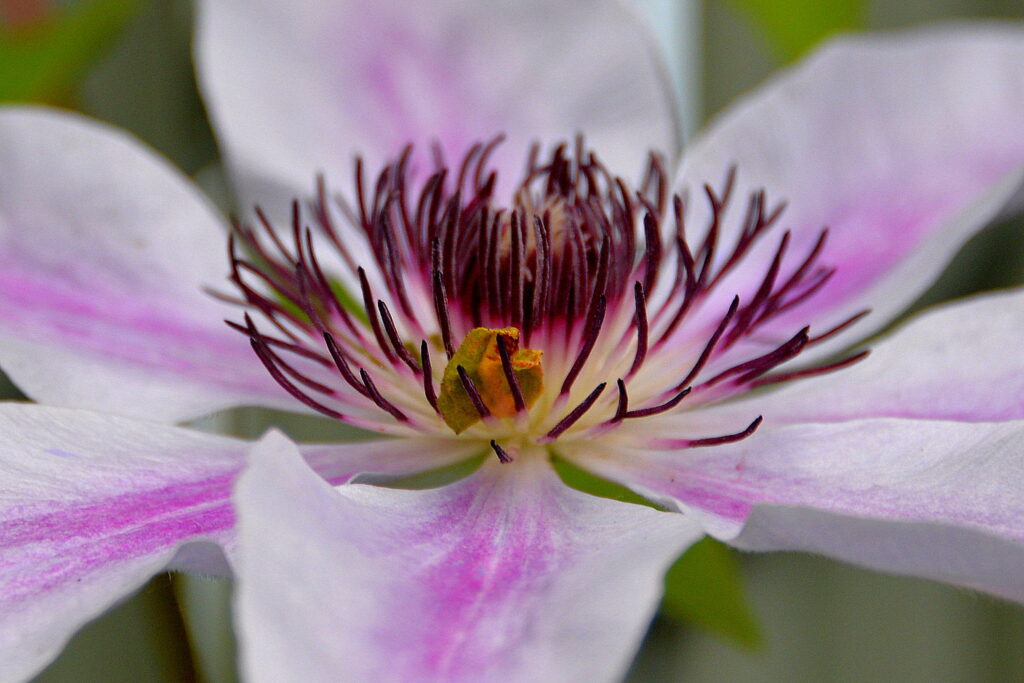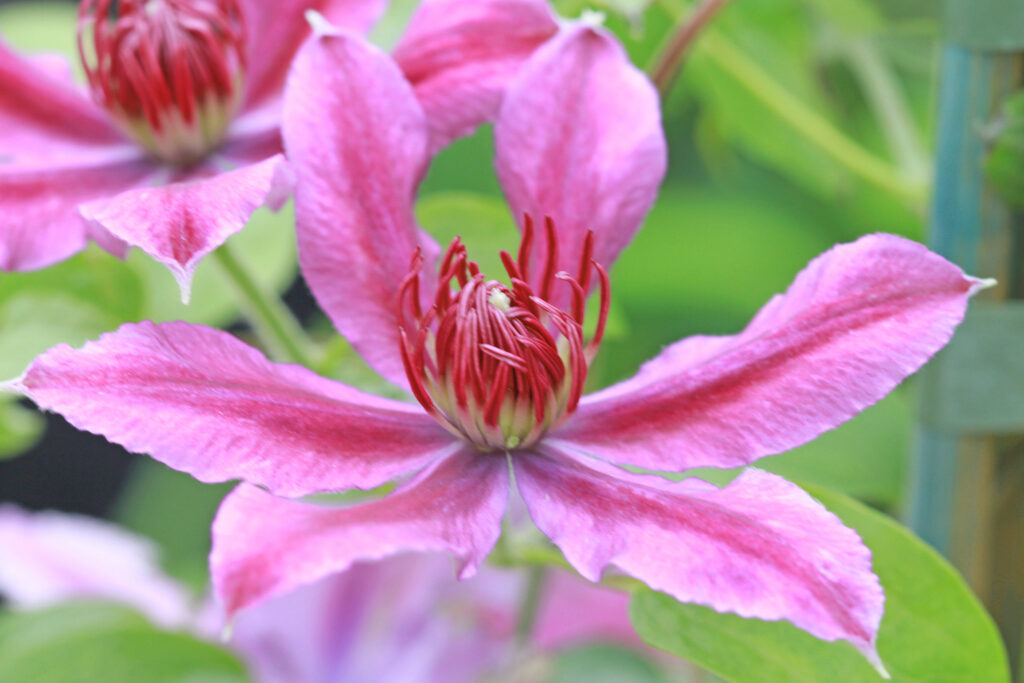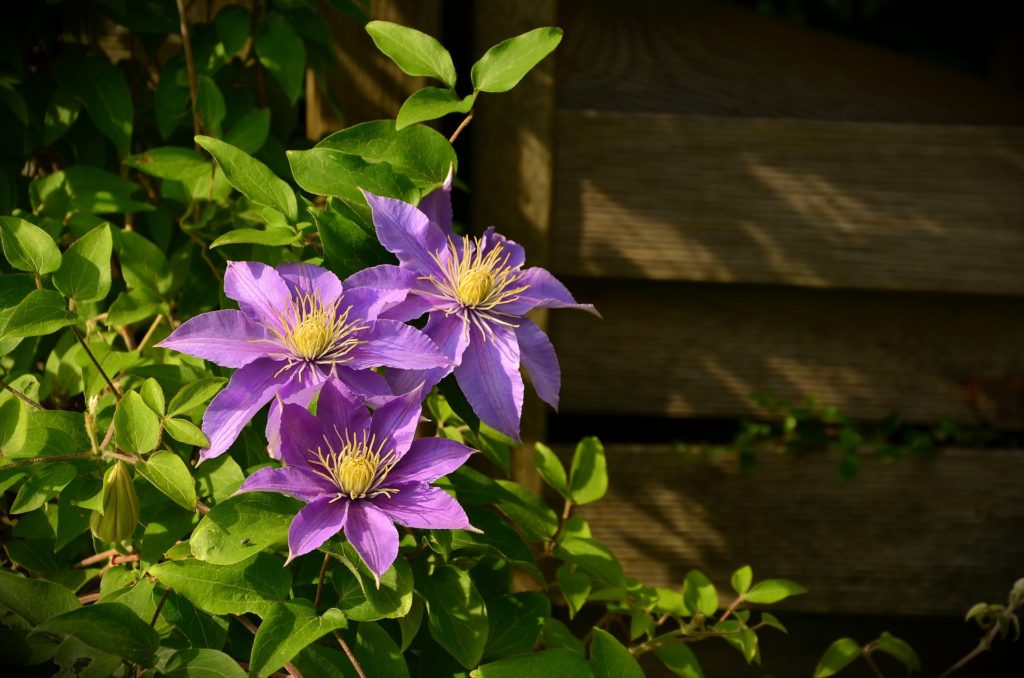[ad_1]
Clematis flowers have hundreds of particular person species from all around the globe, with species native to Eurasia, Africa, Australia, and the Americas. Many are flowering vines that do nicely climbing up a trellis or pergola, and some others are smaller and well-suited to containers. The flower dimension varies for the completely different varieties. A lot of the large-flowered clematis originate from China, Japan, and elsewhere within the far east. Many of those in style varieties had been bred and cultivated in England within the nineteenth century after being imported from China.
The Clematis genus of plant species has three primary classes, the Early Bloomers, Repeat Bloomers, and Late Bloomers. It’s vital to know which group your clematis is in, since that determines when and if pruning ought to happen. The early bloomers don’t require pruning. The repeat bloomers needs to be pruned twice a 12 months, and the late bloomers want spring pruning. Inside these classes are a number of teams of crops, every with a number of particular person varieties.
Clematis: Early Bloomers
Evergreen, blooms from December to April – 20-40 foot vines, 1-4 inch white or pink flowers, no pruning, zones 6-9
Alpine, blooms in April to Could – 6-10 foot vines, 1-2 inch blue, purple, purple, or pink flowers, no pruning, zones 3-9
Macropetala (or downy clematis), blooms in April and Could, some re-bloom in summer time – 8-12 toes vines, 1-3 inch blue or purple flowers, no pruning, zones 4-9
Montana, blooms from April to June – 20-40 foot vines, 1-2 inch white or pink flowers, no pruning, vigorous development, zones 6-9
Rockery, bloom April and Could – as much as 6-foot vines, 1-2 inch white flowers, no pruning, vigorous development, zones 7-9
Clematis: Repeat Bloomers
Early Giant-Flowered, bloom April to June, and once more in August to September, 4-12 foot vines, giant 6-10 inch blue or purple flowers, prune evenly in early spring and once more in early summer time, zones 4-11. This group consists of the favored Clematis Jackmanii.
Clematis: Late Bloomers
Late Giant-Flowered, bloom in summer time or fall, 6-12 foot vines, giant 5-8 inch blue, purple, purple, pink, or white flowers, prune in early spring, zones 4-11.
Herbaceous, bloom in early summer time by fall, 12-24 inches in peak with floor unfold as much as 3 toes, white, blue, or purple flowers, prune in spring, zones 4-11.
Viticella, bloom from June to October or November, 10-15 foot vines, 3-5 inches blue, pink, and purple flowers, prune in early spring, zones 4-11.
Texensis, bloom from June to December, 10-15 foot vines, 1-3 inch purple and orange flowers, prune in early spring, zones 4-8.
Viorna, the leather-based flowers, bloom from July to August or September, 8-12 foot vines, reddish-purple flowers, prune in late winter or early spring, zones 4-9.
Orientalis, bloom from June to November, 15-20 foot vines, 1-3 inch hanging yellow flowers, prune in early spring, zones 4-11.
Late Blended Species, bloom from July to November, 6-30 foot vines (relying on species), 1-2 inch white or purple flowers, prune in late winter or early spring, zones 5-9.
There are a number of sorts of Clematis native to america. The most important group of species is Clematis Texensis, which originated in Texas. The Viorna group consists of two frequent varieties, Clematis Crispa, from the southeastern United States and Clematis Hirsutissima, a small non-vining selection typically referred to as Bushy Clematis which originated within the Pacific Northwest.
ClematisPerennialFull solar, however preserve the roots shaded.Moist and well-drained impartial soil (6.5 to 7.5 pH).Begin cuttings indoors.Plant rooted cuttings within the backyard in the summertime.Bought crops could be planted from mid-spring to fall.Plant 24 inches apartGrowing in containers:
Select a big clay pot with good drainage.
Plant an current plant for greatest outcomes, although cuttings may also be planted.
Preserve it rising in full solar, with the roots and pot shaded.
Repot each three years or so.
Water often, maintaining the soil moist.Local weather Zones: Often 4-9, some varieties hardy right down to zone 2, and a few as much as zone 11.

Clematis could be began from seeds or cuttings, however cuttings are a lot simpler. Seeds take a couple of years to germinate. If you are going to buy a younger clematis from a backyard store, it’s virtually definitely began from a reducing. If you’re doing the cuttings your self from an current plant, do it in the course of the spring season. Cuttings could be taken in summer time or autumn, but it surely’s more durable, the vines are extra mature, and they’re slower to take root. Minimize a couple of vines with a number of leaves branching off the primary stem, however no flowers. With scissors, reduce the vines into sections, an inch or so above every set of branching leaves. This could depart you with a number of sections, every a couple of inches lengthy with a pair of leaves on the prime. Plant units of 4 stems right into a 6-inch large pot with good beginning soil and make sure the soil is agency round every stem.
Preserve them in a moist surroundings. In humid areas, no cowl is required, however when I’ve grown clematis, I’ve discovered it greatest to maintain the pots lined with a big plastic bag. I take advantage of a wire hanger, bent to maintain the bag supported above the cuttings. Not all of the cuttings will take root, however the ones that do will begin rising inside two months. Take away the bag, and they need to develop fairly rapidly at this level. As soon as they get to be 18 inches or so tall, trim them again a bit to encourage branching. Plant them within the backyard in late July or August.
Location is vital. It ought to have good high quality impartial and well-drained soil. Full solar is crucial, however the roots want some shade. I preserve some huge rocks helpful to position across the roots, to maintain the solar off. Companion crops may also be used across the base of the plant. Good ones for clematis embody lettuce and different edible greens, in addition to annual or perennial flowers to assist shade the roots. For clematis, there’s a well-known saying that may be very helpful: “Head within the solar, and toes within the shade.” Different companions could be shrubs and timber to supply a pure trellis.
Clematis needs to be planted with sufficient room to develop totally. Smaller varieties could be planted as shut as 18 inches aside, the biggest vines want 36 inches, however 24 inches is an efficient commonplace distance for many. They are going to want a trellis. Earlier than truly planting them, put up the trellis, one of the best form has a small lattice, about 5 or 6 toes tall. Within the first 12 months, trim them again somewhat by eradicating the tip ends since these coaxes the plant into branching out. Pruning is vital for a lot of varieties, however not the early bloomers. See the outline above for extra particular details about pruning 12 months to 12 months. Younger crops want some safety from the chilly. Begin them after the final frost if you’re planting already rooted clematis within the spring.
Container planting is a well-liked possibility for a lot of varieties of clematis. Smaller varieties are simpler however when you’ve got a good-sized giant pot, the vining varieties will do nicely with a trellis. In some methods, rising in containers is simpler, as a result of this permits them to be moved inside in the course of the coldest climate. Additionally, the soil could be saved moist and recent extra simply.
Use good high quality potting soil blended with sand and compost. Transplant the clematis into a big clay pot with good drainage. The container needs to be no less than 12 inches large, and 18 inches deep. Rigorously fill within the soil across the base of the vine. Water the brand new plant completely. Preserve the pot exterior in full solar with a wire trellis. The roots needs to be shaded. Preserve your plant nicely watered, guaranteeing that the soil stays moist however not soggy. All clematis grown in pots needs to be pruned often for the primary three years, by pinching off the ideas of recent stems. This may divert the plant’s vitality into root growth. After three years, prune as you’d for backyard clematis.

Clematis has a couple of frequent pests to be careful for, similar to aphids, earwigs, and vine weevils. Aphids could be eliminated with a tough spray of water. Earwigs could be prevented by mixing some dishwashing cleaning soap with water and spraying the crops. Vine weevils could be managed by utilizing diatomaceous earth, scattered across the base of the plant.
There are a couple of ailments frequent to clematis. Powdery mildew could be handled with neem oil. Slime flux is proven by a liquid secretion beneath wilting leaves. This can be a greater drawback. The plant needs to be fully eliminated and disposed of away from the backyard, and the soil needs to be changed. Clematis wilt is probably the most well-known illness. The stem will flip black and collapse. This isn’t at all times deadly, clematis can get better from this. Contaminated leaves and stems needs to be eliminated and punctiliously gathered from across the base of the plant to forestall additional an infection.
Ailments could be prevented by selecting resistant varieties, selecting wholesome planting websites with a number of good solar, and well-drained wholesome soil. Be sure you water at floor stage, and never by spraying from above. Weed rigorously and preserve the plant free from fallen leaves and stems.
If you wish to try the problem of propagating by seeds, wait till the flowers are fully ripe and are beginning to flip brown. The seed heads will probably be inexperienced and have some hairs rising round them. Clip some seed heads and open them over a container, and verify the colour. Brown seeds are ripe, inexperienced ones are usually not. They are often planted immediately within the backyard, however keep in mind that it could take a couple of years for them to germinate and sprout.
As soon as they’re established, clematis is extraordinarily straightforward to look after and so they dwell for many years! These great sorts of vining flowers will final a lifetime and create a gorgeous backdrop on any fence, or pergola or be a gorgeous long-term addition to your potted plant assortment.
[ad_2]
Supply hyperlink
